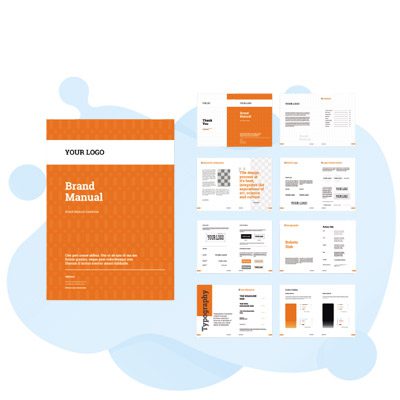Best Tips For Brand Style Guides 2025

If you are struggling to find the best way to convey your brand identity in a visual way, a Brand Style Guide can be just what you need. This guide can clarify color requirements and file formats to help you create and distribute content that’s consistent with your company’s image. It can also clarify brand messaging guidelines, including what to include in standard marketing promotions, premium content and user referral links. Brand messaging guidelines can make a huge difference in your company’s promotion efforts and ultimately help you attract more customers.
Free Brand Style Guide Practice Test Online
Brand Style Guides Questions and Answers
A brand style guide is a comprehensive set of guidelines that establishes the branding of your business. Grammar, tone, logo usage, colors, graphics, word choice, point of view, and other elements are all mentioned.
- Your brand style guide should begin with a compelling brand narrative.
- Create a recognizable brand signature using logo guidelines.
- Include the primary color scheme for your brand.
- Establish a typographic hierarchy.
- Create a brand voice.
- Indicate the images and symbols that make up your visual language.
Depending on your chosen graphic designer, a brand style guide can cost anywhere from $60 to $350.
A brand style guide is a digital handbook that details every element of your brand’s appearance and tone. In addition to being used internally, a brand style guide is distributed to partners, the media, and advertising agencies to inform them of the proper and consistent ways to represent your brand.
Brand Style Guide Template
A brand style guide is a document that outlines how you want all your visual assets to look. It serves as a reference for designers, marketers, and writers to create content that is consistent with the brand’s identity. It can be a comprehensive document, or it can be broken down into smaller guides.
For example, a brand style guide should include examples of fonts. Fonts can play a vital role in sales collateral and marketing collateral, so it’s crucial to specify and use consistent fonts. In addition, brand guidelines should include examples of images. Images are important tools in communicating with your audience, so it’s essential to use consistent images.
If you’re planning to create a brand guide for your company, consider downloading a brand style guide template. These documents are easy to use and contain information about brand colors and fonts. You can use them for your brand guidelines rulebook or as a separate document for employees.
Brand Style Guide Examples
A style guide can be a useful tool to keep your team on brand when working with a design team. It should include dos and don’ts and should be specific to your brand. Generally, a style guide should include six essential elements, but some brands may need more detailed guidelines.
The brand style guide of Bay Area Rapid Transit (BART), for instance, includes extensive information on how a company’s logo and brand assets should be designed. The guide is comprehensive, covering everything from app assets to printed stationery. The company even offers an interactive website that makes it easy for users to access the style guide.
Another example of a brand style guide is the Style Guide of Child of Light, a video game. This guide deconstructs its logo in detail, and includes a ton of information on the creative process.

What is a Brand Style Guide?
Brand style guides can help define your company’s style. Having a unified brand message is vital to your success, and a style guide can help ensure consistency throughout your communications. Consistent communication helps establish trust and brand loyalty. Brand style guides can help you develop your logo, ad copy, and other visual materials to reflect your brand’s personality and values. You can even incorporate your mission statement into your brand style guide.
A style guide should also contain guidelines for imagery. Ideally, your brand should use photographs that feature real people performing real work. You should use lighting that is either natural or subtle. For example, LinkedIn’s photos are not posed; they are shot by real people who do not look at the camera.
Brand style guides can be as simple or complex as you need them to be. They should include five basic components: your mission, vision, target audience, brand personality, and core values. A brand style guide should cover these five elements and should be easily accessible. It should also be personalized to your company’s needs.
How to Create a Brand Style Guide?
Creating a brand style guide is a great way to create cohesive, on-brand content. A style guide should be easy to read and concise, with examples that illustrate the use of particular brand elements. It should also be flexible and adapted to your brand’s needs. You can find free templates for brand style guides on the Internet.
Creating a brand style guide will help you align your business interests with those of your audience. It will help you determine the color palette, tone, and feel of your brand. It will also help you roll out your brand assets consistently across all channels and ensure that your audience remembers the distinct point of view of your brand.
A brand style guide should include a company’s vision and mission. These two elements communicate the brand’s long-term purpose and help build credibility. They are important in brand recognition because they are at the core of all interactions with the company. The brand’s mission and values will guide tone, aesthetics, and other aspects of the brand’s communication strategy. A brand style guide should also include a company’s unique selling proposition (USP), which will tell your audience how the brand differs from your competitors.
Style Guide vs Brand Guide
There’s an important difference between a style guide and a brand guide. While a style guide is an excellent resource for visual design, a brand style guide focuses on how a brand wants to be perceived and can be more creative than a style guide. It should contain dos and don’ts as well as examples of messaging. While most brands will only need a brand style guide, some may require more in-depth guidance.
Creating a style guide can help you create consistent copy. A style guide provides rules for the proper usage of words and grammar. However, some people may wish to use their own exceptions to these rules, such as capitalizing some prepositions or abbreviations. They may also want to use the Oxford comma in their content.
A style guide is great for daily use, as well as for communicating with partners and the media. It can help ensure consistency and ensure that different departments use the same fonts, colors, and images. A brand guide, on the other hand, is more useful for larger teams and is meant for all employees.

What to include in a Brand Style Guide?
A brand style guide should include five key components: audience, personality, values, mission, and vision. These aspects help designers create consistent, clean communications. In addition, the guide should include specific notes about your brand voice. This will help your audience understand your brand. You can also use this guide to help your company decide how to use its voice and image.
Colors are another key part of your brand style guide. Each brand should have a core palette of brand colors, which should be specified in the style guide. These colors should be specified in CMYK, RGB, or Pantone code forms. The guide should also include a section on typography, including specific fonts and how to access them. In addition to hex values and RGB values, your brand style guide should also include examples of shades of each color.
A brand style guide should be made available in both print and digital format. It should include do’s and don’ts for logos, fonts, and colors, as well as examples of how to use them. In addition, the guide should include all elements of a brand strategy.
Brand Style Guide Book
A brand style guide book can help you create a cohesive look and feel for your brand. It can include concrete examples of your brand’s style, notes on the brand’s voice, and more. These guidelines are important to help your company communicate its message consistently. This document can also be used as an organizational tool within your company.
In addition to having the basic structure of your brand style guide, you should also consider how your brand colours are used. For example, the brand colours can be used on a website, in advertising, and on printed material. A brand style guide book should also include the specific colour codes for the different mediums.
If you are using more than one logo, you should consider having a support logo design. This should follow the same branding principles as your primary logo, but may have a different orientation or design. It can also be simpler to create so it can support the main logo more easily. The purpose of these supporting logos is to make sure the primary logo remains prominent and consistent, but is not too overwhelming.
Brand Style Guide Cost
Creating a brand style guide is an important part of any branding project, and the costs can vary widely. The amount you pay will depend on how many people are working on the project and how detailed you want the guide to be. A graphic designer can help you with this task, but the cost will also depend on the desired result. For example, an established landscaping company can spend as little as $500 to create a formal brand style guide.
The process of creating a brand style guide is relatively simple. You can use brand style software to create an email signature that promotes your brand. Other branding materials can also be created with these programs. If you are looking for a way to create a brand style guide without having to spend a lot of money, there are many free programs available.
While a brand style guide should be customized to your company’s needs, it’s always a good idea to choose a design that fits your brand’s identity. Choosing a font for the guide is an essential step in ensuring a consistent brand experience. Choosing a font that is not consistent with the rest of the design could lead to confusion and poor brand recognition.